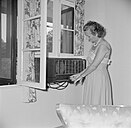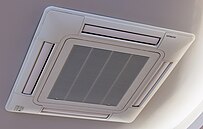**1. History and Development of Air Conditioning:**
– Air conditioning dates back to prehistory with double-walled living quarters in ancient Syria.
– Passive air-conditioning techniques were used in ancient Egyptian buildings and spread through various regions.
– Powered air conditioning replaced passive techniques in the 20th century.
– Key developments include experiments by Giambattista della Porta, Cornelis Drebbel, Benjamin Franklin, and John Hadley.
– Modern air conditioning technology evolved with discoveries by Michael Faraday and John Gorrie.
– Notable milestones include the invention of the first modern electrical air conditioning unit in 1901.
**2. Types of Air Conditioners and Usage Impact:**
– Various types of air conditioners include window-mounted, ceiling-mounted, wall-mounted, and console units.
– As of 2018, 1.6 billion air conditioning units were installed globally.
– Air conditioning accounts for 20% of electricity usage in buildings.
– The number of air conditioning units is projected to reach 5.6 billion by 2050.
– Sustainable air conditioning is advocated by the United Nations to combat climate change.
**3. Benefits and Operation of Air Conditioning:**
– Air conditioners maintain a consistent indoor environment regardless of external conditions.
– They enable the construction of deep plan buildings and provide comfort in hot regions.
– Cooling technology has advanced to include heat pumps for both cooling and heating.
– Air source heat pumps are increasingly used for heating and cooling in cooler climates.
– Operation involves the vapor-compression cycle, dehumidification, and free cooling options.
**4. Heating and Performance of Air Conditioning Systems:**
– Some air conditioning systems can function as air source heat pumps for heating.
– Heat pumps are more energy-efficient than electric resistance heating.
– Performance is measured by the coefficient of performance (COP) and seasonal energy efficiency ratio (SEER).
– Operating conditions impact the efficiency of air conditioning systems.
– Newer models have improved cold-weather performance down to -26°C.
**5. Control Systems and Capacity Ranges of Air Conditioners:**
– Control systems include wireless remote controls and wired controllers for operation.
– Capacity ranges vary from very small units to very large units based on kW output.
– Mini-split and multi-split systems offer ductless air distribution and independent conditioning of multiple rooms.
– Each room in multi-zone systems has its own indoor unit for simultaneous conditioning.
– Control systems play a crucial role in managing the operation and efficiency of air conditioning units.
This article has multiple issues. Please help improve it or discuss these issues on the talk page. (Learn how and when to remove these template messages)
|
Air conditioning, often abbreviated as A/C (US) or air con (UK), is the process of removing heat from an enclosed space to achieve a more comfortable interior environment (sometimes referred to as 'comfort cooling') and in some cases also strictly controlling the humidity of internal air. Air conditioning can be achieved using a mechanical 'air conditioner' or by other methods, including passive cooling and ventilative cooling. Air conditioning is a member of a family of systems and techniques that provide heating, ventilation, and air conditioning (HVAC). Heat pumps are similar in many ways to air conditioners, but use a reversing valve to allow them both to heat and to cool an enclosed space.
Air conditioners, which typically use vapor-compression refrigeration, range in size from small units used in vehicles or single rooms to massive units that can cool large buildings. Air source heat pumps, which can be used for heating as well as cooling, are becoming increasingly common in cooler climates.
According to the International Energy Agency (IEA), as of 2018, 1.6 billion air conditioning units were installed, which accounted for an estimated 20% of electricity usage in buildings globally, with the number expected to grow to 5.6 billion by 2050. The United Nations called for the technology to be made more sustainable to mitigate climate change and for the use of alternatives, like passive cooling, evaporative cooling, selective shading, windcatchers, and better thermal insulation. CFC and HCFC refrigerants such as R-12 and R-22, respectively, used within air conditioners have caused damage to the ozone layer, and HFC refrigerants such as R-410a and R-404a, which were designed to replace CFCs and HCFCs, are instead exacerbating climate change. Both issues happen due to the venting of refrigerant to the atmosphere, such as during repairs. HFO refrigerants, used in some if not most new equipment, solve both issues with an ozone damage potential (ODP) of zero and a much lower global warming potential (GWP) in the single or double digits vs. the three or four digits of HFCs.
Definition from ChatGPT:
Air conditioning:
Air conditioning is a system or process that cools and dehumidifies air in an enclosed space, typically a building or vehicle, to provide a more comfortable environment for occupants. This is achieved by removing heat and moisture from the air through a refrigeration cycle, resulting in lower temperatures and improved air quality.



